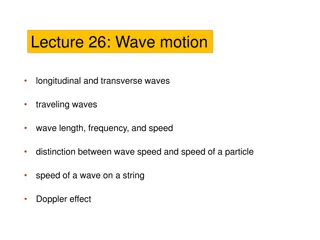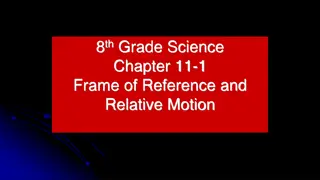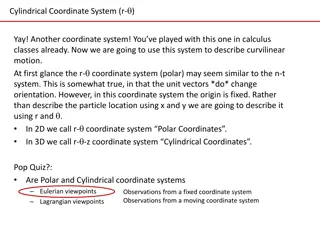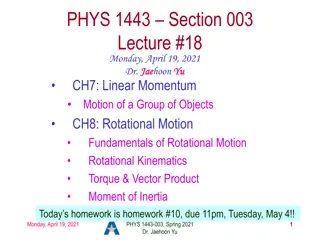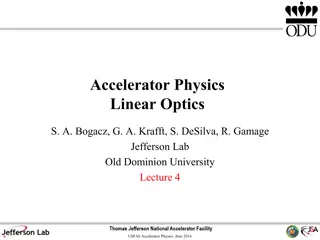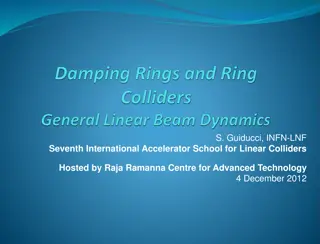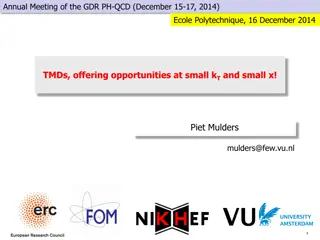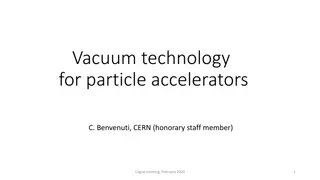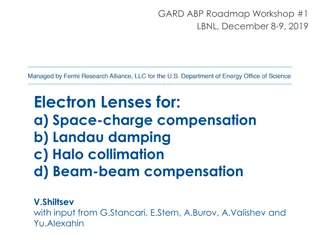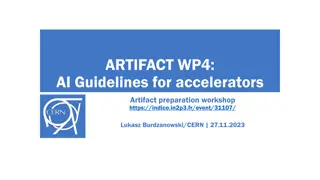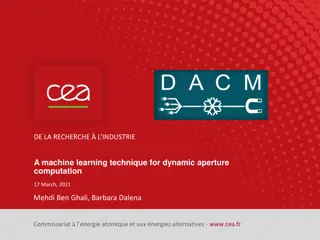Transverse Motion in Particle Accelerators
Exploring the formalism and calculations related to transverse motion in particle accelerators, including the Hill equation, transfer matrices, lattice functions, and example drift calculations. The content delves into the mathematical foundations and practical applications of analyzing particle beam dynamics in accelerators.
Uploaded on Sep 20, 2024 | 3 Views
Download Presentation

Please find below an Image/Link to download the presentation.
The content on the website is provided AS IS for your information and personal use only. It may not be sold, licensed, or shared on other websites without obtaining consent from the author.If you encounter any issues during the download, it is possible that the publisher has removed the file from their server.
You are allowed to download the files provided on this website for personal or commercial use, subject to the condition that they are used lawfully. All files are the property of their respective owners.
The content on the website is provided AS IS for your information and personal use only. It may not be sold, licensed, or shared on other websites without obtaining consent from the author.
E N D
Presentation Transcript
Transverse Motion 2 Eric Prebys, FNAL
Some Formalism x + = ( ) 0 K s x Let s look at the Hill equation again We can write the general solution as a linear combination of a sine-like and cosine-like term where ( ) ( aC s x = ) 0 ( ; 1 ) 0 ( = S C + 0 = ) ( ) s = bS s = C S ) 0 ( ; 0 ) 0 ( 1 When we plug this into the original equation, we see that ( ( ) ( ) ( + s C s K s C a ) ( ) 0 = + + ) ( ) ( ) ( ) b S s K s S s Since a and b are arbitrary, each function must independently satisfy the equation. We further see that when we look at our initial conditions ) 0 ( ) 0 ( ) 0 ( S b C a x + = = + = = x aC bS a = a x 0 x 0 = ) 0 ( ) 0 ( ) 0 ( b b So our transfer matrix becomes ) ( s x ( ) ( ) ( ) ( ) x x x s x s C s S s 0 0 = = M 0 0 ( ) ( ) ( ) x x x s C s S s Lecture 4 - Transverse Motion 1 USPAS, Knoxville, TN, Jan. 20-31, 2013 2
Calculating the Lattice functions If we know the transfer matrix or one period, we can explicitly calculate the lattice functions at the ends M + sin sin cos sin sin = cos 1 ( ) M = = 2 cos ; sin 1 cos Tr 2 If we know the lattice functions at one point, we can use the transfer matrix to transfer them to another point by considering the following two equivalent things Going around the ring, starting and ending at point a, then proceeding to point b Going from point a to point b, then going all the way around the ring + = + M M M M ( , ) ( M , ) ( , ) ( , ) s C s s s s s + s C s sb b b b a b a C a M a + = 1 M M ( , ) ( , ) ( , ) ( , ) s C s s s s s s s b b b a a a b a sa Recall: ( ) s ( ) s s s J ( ) s ( ) ( ) + = + I M I J ( , ) cos M 2 ( ) sin 2 + s C s s ( ) + = 1 I J J M cos 2 ( ) sin 2 ( , ) M cos 2 ( M ) sin 2 ( , ) s s s = s s s b b a a b a 1 J J ( ) ( , ) ( ) ( , ) s s s s s s b b a a b a Lecture 4 - Transverse Motion 1 USPAS, Knoxville, TN, Jan. 20-31, 2013 3
Calculating the Lattice functions (contd) 22 21 m m m m m m Using 11 12 22 12 = 1 M M ( , ) ( , ) s s s s b a b a m m 21 11 We can now evolve the J matrix at any point as ( ) ( ) ( ) ( ) s s s s m m m m 11 12 22 12 b b a a = = J ( ) s b ( ) ( ) ( ) ( ) s s s s m m m m 21 22 21 11 b b a a Multiplying this mess out and gathering terms, we get ( ( ( 2 ) ( 21 b m m s ) ( ) ( ) + ( ) ( ) s m m m m m m m m s 11 22 12 21 11 21 12 22 b a ( ( ) ) ( ( ) ) ) ) = 2 11 2 12 ( ) 2 ( ) s m m m m s 11 12 b a 2 21 2 22 ( ) m m s 22 a Lecture 4 - Transverse Motion 1 USPAS, Knoxville, TN, Jan. 20-31, 2013 4
Examples Drift of length L: a(s)=a0-g0s b(s)= b0-2a0s+g0s2 g (s)=g0 a(s) b(s) g (s) a(0) b(0) g (0) -s s2 1 1 0 1 0 1 0 1 s M = = -2s 0 Thin focusing (defocusing) lens: 1 f 1 f = 1 0 0 0 1 0 0 1 f = = = M 0 1 0 1 0 0 2 f 1 f 2 f 1 f 1 = + 0 2 0 0 0 2 Lecture 4 - Transverse Motion 1 USPAS, Knoxville, TN, Jan. 20-31, 2013 5
Physical Implications = A ; = + cos ( ) x A s The general expressions for motion are ( ) = + cos sin x We form the combination g x2+2ax x +b x = A2g bcos2f -2a2cos2f -2asinfcosf +a2cos2f +sin2f +2asinfcosf ( = A2 g b -a2 ( = A2= constant 2 ) ( ) )cos2f +sin2f If you don t get out much, you recognize this as the general equation for an ellipse ' x A Area = A2 A Particle will trace out the ellipse on subsequent revolutions x Lecture 4 - Transverse Motion 1 USPAS, Knoxville, TN, Jan. 20-31, 2013 6
Interpretation (contd) As particles go through the lattice, the Twiss parameters will vary periodically: s x x x x x x x x x x = max = 0 maximum = decreasing >0 focusing = min = 0 minimum = increasing < 0 defocusing Motion at each point bounded by ( ) ( ) x s A s Lecture 4 - Transverse Motion 1 USPAS, Knoxville, TN, Jan. 20-31, 2013 7
Conceptual understanding of It s important to remember that the betatron function represents a bounding envelope to the beam motion, not the beam motion itself Normalized particle trajectory Trajectories over multiple turns ( ) / 1 2 = + ( ) ( ) sin ( ) x s A s s s ds ( (s)is also effectively the local wave number which determines the rate of phase advance 0 = ( ) s ) s Closely spaced strong quads small small aperture, lots of wiggles Sparsely spaced weak quads large large aperture, few wiggles Lecture 4 - Transverse Motion 1 USPAS, Knoxville, TN, Jan. 20-31, 2013 8
Betatron tune Particle trajectory As particles go around a ring, they will undergo a number of betatrons oscillations (sometimes Q) given by 1 Ideal orbit ds = 2 ( ) s This is referred to as the tune We can generally think of the tune in two parts: 6.7 Integer : Fraction: Beam Stability magnet/aperture optimization 9 Lecture 4 - Transverse Motion 1 USPAS, Knoxville, TN, Jan. 20-31, 2013
Tune, stability, and the tune plane (We ll talk about this in much more detail soon, but in general ) If the tune is an integer, or low order rational number, then the effect of any imperfection or perturbation will tend be reinforced on subsequent orbits. When we add the effects of coupling between the planes, we find this is also true for combinations of the tunes from both planes, so in general, we want to avoid (resonant integer = y y x x k k instabilit y) fract. part of Y tune Avoid lines in the tune plane small integers fract. part of X tune Many instabilities occur when something perturbs the tune of the beam, or part of the beam, until it falls onto a resonance, thus you will often hear effects characterized by the tune shift they produce. Lecture 4 - Transverse Motion 1 USPAS, Knoxville, TN, Jan. 20-31, 2013 10
Emittance If each particle is described by an ellipse with a particular amplitude, then an ensemble of particles will always remain within a bounding ellipse of a particular area: 2 + + x x x ' x x = 2 or x Area = Either leave the out, or include it explicitly as a unit . Thus microns (CERN) and -mm-mr (FNAL) Are actually the same units (just remember you ll never have to explicity use in the calculation) 11 Lecture 4 - Transverse Motion 1 USPAS, Knoxville, TN, Jan. 20-31, 2013
Definitions of Emittance and Admittance Because distributions normally have long tails, we have to adopt a convention for defining the emittance. The two most common are Gaussian (electron machines, CERN): 2 = contains ; 39% of the beam x 95% Emmittance (FNAL): e95=6psx 2 ; contains 95% of the beam b It is also useful to talk about the Admittance : the area of the largest amplitude ellipese which can propagate through a beam line d A = Limiting half-aperture 2 Lecture 4 - Transverse Motion 1 USPAS, Knoxville, TN, Jan. 20-31, 2013 12
Adiabatic Damping Printed copy has lots of typos! In our discussions up to now, we assume that all fields scale with momentum, so our lattice remains the same, but what happens to the ensemble of particles? Consider what happens to the slope of a particle as the forward momentum. p + p + = 1 x x x x p p p p = 0 0 x x xp xp 0p p = x x + 0p p p p 0 0 If we evaluate the emittance at a point where =0, we have e =p gTx2+bT x ( ) 2 2dp p= -2edp ( ) de = 2pbT x d x = -2pbT x psin2y +d p de p0 p= e0 de = -edp = -dp p ep = constant = e0p0 eN gb e g0b0 gb Normalized emittance e = e0 Lecture 4 - Transverse Motion 1 USPAS, Knoxville, TN, Jan. 20-31, 2013 13
Mismatch and Emittance Dilution In our previous discussion, we implicitly assumed that the distribution of particles in phase space followed the ellipse defined by the lattice function ' x Lattice ellipse ' x but there s no guarantee What happens if this it s not? x x Injected particle distribution Area = Once injected, these particles will follow the path defined by the lattice ellipse, effectively increasing the emittance ' x x Effective (increased) emittance Lecture 4 - Transverse Motion 1 USPAS, Knoxville, TN, Jan. 20-31, 2013 14
Beam Lines In our definition and derivation of the lattice function, a closed path through a periodic system. This definition doesn t exist for a beam line, but once we know the lattice functions at one point, we know how to propagate the lattice function down the beam line. ( out, M ) in out in out in out in ( ) ( ) ( ) + m m m m m m m m 11 22 2 12 21 11 21 12 22 out in ( ( ) ) ( ( ) ) ( ( ) ) = 2 11 2 12 m m m m 11 12 out in 2 21 2 22 2 m m m m 21 22 out in Lecture 4 - Transverse Motion 1 USPAS, Knoxville, TN, Jan. 20-31, 2013 15
Establishing Initial Conditions When extracting beam from a ring, the initial optics of the beam line are set by the optics at the point of extraction. in in in For particles from a source, the initial lattice functions can be defined by the distribution of the particles out of the source in in in Lecture 4 - Transverse Motion 1 USPAS, Knoxville, TN, Jan. 20-31, 2013 16




